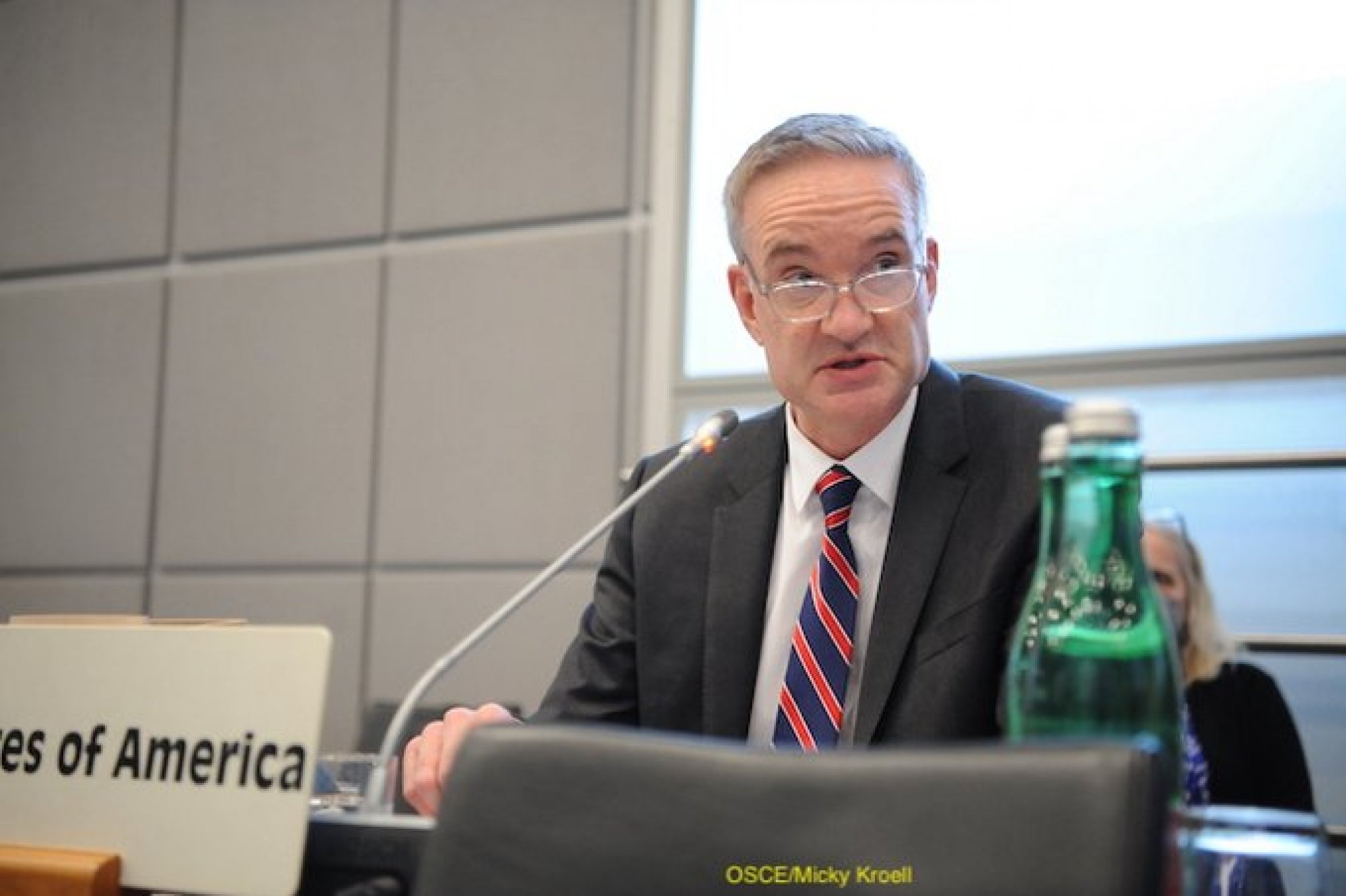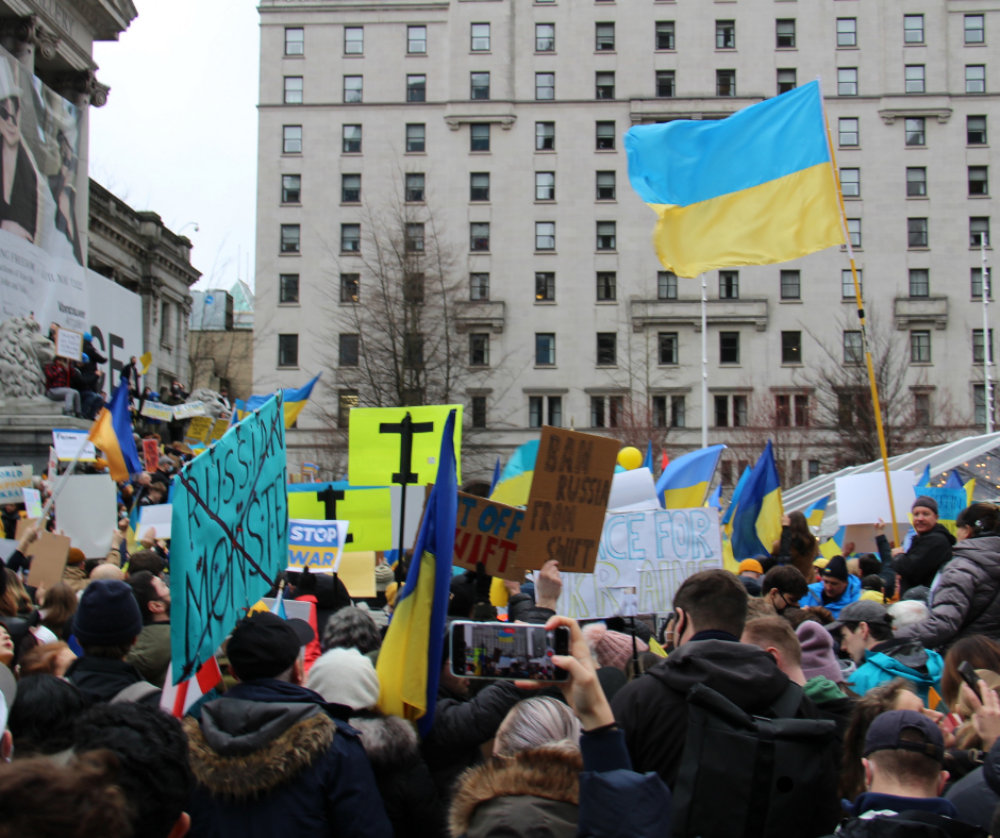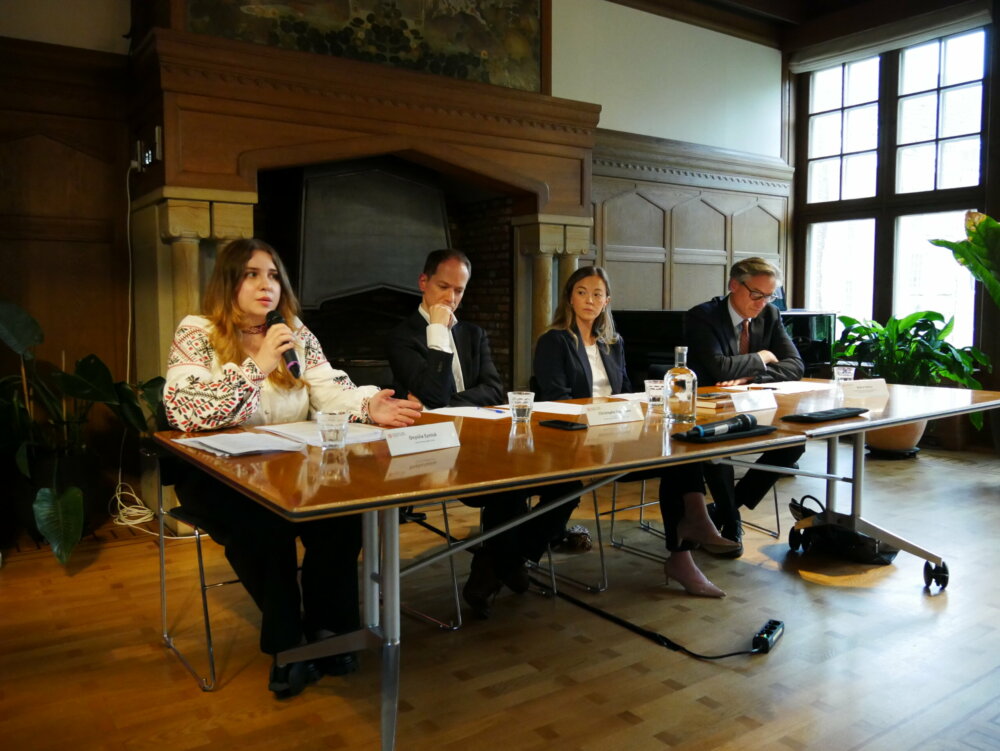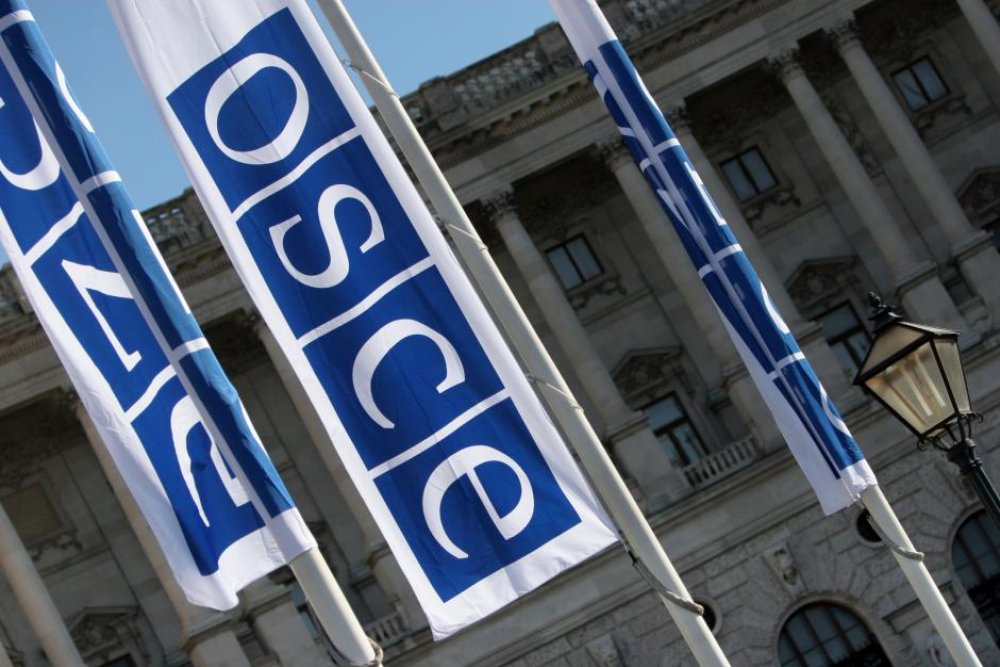OSCE/Micky Kroell

U.S. OSCE Ambassador: It Would Be A ‘Strategic Catastrophe’ If Russia Decided To Escalate
Tensions between Russia and the West are at their highest in years. Russia has amassed more than 100,000 troops along the border with Ukraine as well as in Belarus, raising fears of a Russian invasion. In December, Moscow put forward a draft treaty on security guarantees, demanding that NATO end its eastward expansion and withdraw forces and armaments from Central and Eastern Europe. The United States replied to the Russian draft treaty in a separate confidential non-paper in January, which was leaked to Spanish newspaper El Pais. In that non-paper, the U.S. formally rejected Russia’s core demand to end the eastward expansion of NATO, but agreed to discuss a number of other issues, including confidence-building measures, military transparency measures, risk reduction measures and incident prevention, also within the OSCE context.
In this interview, Ambassador Michael Carpenter, the U.S. Ambassador to the OSCE, explains some of these proposals in more detail and highlights where he sees the role of the OSCE in helping to de-escalate current tensions.
SHR Monitor: The Polish OSCE Chairpersonship will launch the Renewed OSCE European Security Dialogue tomorrow in Vienna to address the growing tensions and risk of further military escalation in Europe. What do you concretely expect from this process? What topics will be discussed?
Michael Carpenter: We strongly support the suggestion and initiative by the Polish Chairperson-in-Office, Foreign Minister Zbigniew Rau, to host this timely discussion. We think that there is clearly a crisis in European security at the present time, and we think it’s very important to privilege dialogue and diplomacy over the alternative, which is confrontation and escalation.
This is an opportune moment to sit down with all other 56 OSCE participating states and have a discussion about the concerns we all have. Obviously, there are different concerns among different participating states about the present state of European security.
From the U.S. perspective, we are gravely concerned by Russia’s build-up of troops and equipment at the border with Ukraine as well as in Belarus. We are also concerned by the bellicose rhetoric and the disinformation that we see coming from Russia. We think it is a good time to have a discussion about our various concerns. If things go well, we can potentially address some of those concerns here at the OSCE.
In what way will the process suggested by the Polish OSCE Chair be different from previous processes within the context of the OSCE? I am specifically thinking of the Corfu process (and later the Helsinki+40 process), which was initiated by the OSCE following the Russian invasion of Georgia and Dmitry Medvedev’s suggestion to create a new European security treaty in 2008. While this previous discussion process has ended in the adoption of documents and in a summit meeting, it seems that it has failed to improve the overall security situation and solve the core issues.
Ever since the mid 1970s, the CSCE and later the OSCE have engaged in discussions with all the players in Europe and Eurasia to discuss concerns and try to see if we can build confidence, strengthen transparency, and reduce the risk of conflict. Back then it included the Soviet Union and now it includes various independent states.
At different times in history we have better succeeded with those goals, and been able to implement concrete commitments — sometimes they even became legally-binding treaties, such as the Treaty on Conventional Armed Forces in Europe. We have also produced landmark transparency instruments, such as the Vienna Document on Confidence- and Security-Building Measures.
At other times, we have failed to agree on specific measures. But in spite of this, it is incumbent on us, the OSCE participating states, to try as best as we can to reduce tensions and find common ground, no matter how difficult that may be. I think the Polish OSCE Chair is wise to launch this process now.
Tomorrow there will be an official high-level launch event of this process in Vienna. Can you say who will attend on behalf of the United States?
I don’t have an announcement for you today. But I think we will have senior-level attendance at this event, commensurate with the fact that we see this as a very serious, high-level process.
I know this is probably difficult for you to answer, but do you expect Russia to come on board? Their initial reaction to the Polish initiative was very skeptical.
You would have to ask my Russian colleague, Ambassador Alexander Lukashevich. What I can tell you is that Russia has voiced a number of concerns. Frankly, I am not sure that I agree with all of their concerns. We have also seen Russia invade two of its neighbors in the last 15 years and so we have very grave concerns about Russian behavior.
But if Russia walks away from dialogue and from diplomacy at a moment when they claim to have concerns, well, that’s not commensurate with an interest in de-escalation and diplomacy at all.
In fact, it would be just the opposite. It would show that they never had any intention of pursuing diplomacy from the very beginning. So, I hope that they do participate both here at the OSCE and in other formats where we are discussing European security. Because diplomacy is really the solution to this conflict and not escalation and the use of military force.
Looking at the U.S. reply to the Russian draft treaty on security guarantees, it is clear that the U.S. will not compromise on the key Russian demand to halt further eastward expansion of NATO — a demand which is now also supported by China. However, there are many other proposals in the U.S. response, with the OSCE mentioned several times in Washington’s reply to the Russian draft treaty. Have you made concrete progress in consulting with other OSCE states and the Polish OSCE Chair about which of those proposals could actually be taken up in the OSCE context and further developed?
We have said that there is no room for negotiation on the fundamental principles that we support and which are enshrined in the 1975 Helsinki Final Act, in the 1990 Charter of Paris, in the 1999 Charter on European Security, and in other founding documents. But as you rightly noted, we have proposed working on a variety of different issues where we think that we can make progress. It remains to be seen whether the Russian side has similar interests.
These areas include confidence-building measures, certainly transparency measures with regard to troops and exercises, potential reciprocal restraints in that capacity, risk reduction, and crisis communication. Those are all areas in which we already have various instruments and measures in place, and we would like to make them more robust and strengthen them.
Finally, in the context of Ukraine and other conflicts, such as Georgia, we would seek to have a discussion about how we can better implement the proposals that are on the table. In the case of Ukraine, that includes the Minsk Agreements. We would like to discuss how we can move forward to achieve Ukrainian sovereignty and territorial integrity.
We believe that the party that is not implementing those agreements is Russia. Ukraine, on the other hand, has made a very good faith effort to implement the agreements. What we need to see happening on the ground is a ceasefire, the withdrawal of heavy weapons, and unfettered access for OSCE monitors. None of this is currently happening.
We now put the ball back in the Russian court and ask: Do they want to engage in de-escalation? Or do they want military confrontation? It is their choice. We will be ready either way.
One of the concrete documents that you have already mentioned and that the OSCE already has in place is the 2011 Vienna Document, which provides for military transparency, mutual inspections, exchange of military information, as well as notifications and observations of military exercises. But that hasn’t been updated and modernized since 2011 and is also not applied. What needs to happen to unblock this situation?
The most important thing that needs to change is that Russia has to meet its commitments under the Vienna Document. As you rightly noted, the last version of the document was issued in 2011 and Russia is obligated under its transparency measures to notify other OSCE participating states about exercises and troop movements and to host observation visits by other states. It has largely failed to do that for various reasons.
It does not build trust when you evade transparency. This certainly undermines the spirit of the Vienna Document, if not the actual letter.
We would like to update the Vienna Document and modernize it. We would like to look at some of the thresholds for observations and notifications, and perhaps enhance some of the transparency measures so that we can get a better sense of what we are seeing in terms of troops and equipment in various locations.
Let’s be clear that NATO countries are implementing their commitments under the Vienna Document and Russia is not. It starts with implementation — then we can talk about modernization.
There are also other agreements that have been concluded under the umbrella of the OSCE in the past that also address transparency and create confidence, such as the 1992 Open Skies Treaty. I would be interested in understanding why the U.S. under the Biden administration has not made more effort to revise the decision by the previous U.S. administration to withdraw from the Treaty. Are there any special reasons for that? Isn’t the Open Skies Treaty precisely the kind of instrument that would be needed now since it provides states parties with the possibility to overfly each other’s territories so that they can monitor the other states’ military activities from the sky and thereby build confidence that neither side is preparing for war or a surprise attack?
The Open Skies Treaty is an instrument that does provide transparency, but it also allows states, including Russia, to overfly sensitive military facilities. So, there has always been a tension between what can be used under that sort of an arrangement to gain intelligence on critical infrastructure, for example, and then the transparency side of the Treaty. This is the case with any arms control instrument.
So, the previous administration did decide to withdraw from the Open Skies Treaty.
The simple reality now is that it is difficult to envision that the Treaty would pass the two-thirds majority that it would need in the U.S. Senate to become legally-binding again. Given the political realities that we face on that score, there is not a feasible pathway forward for the U.S. — at least at this point in time — to re-join the Open Skies Treaty.
But we are open to exploring various creative ways of implementing transparency measures.
I would also note that the Open Skies Treaty is already several decades old and there is now newer technology in place that is more sophisticated. That modern technology can be used to provide greater transparency and confidence that other states aren’t about to invade their neighbors. I think this is a very useful conversation that we can have in the future.
Could there be a new version of something like the Open Skies Treaty?
It is a little too early to say at this stage, but I think we would be happy to begin a conversation that considers new forms of transparency and new measures to capture transparency.
We should also keep in mind that there are new forms of military equipment in use today that did not exist in the 1990s, including drones and more sophisticated electronic warfare systems. We might want to capture those new capabilities with a new transparency arrangement.
But if states were interested in spying on one another, there are far more sophisticated satellite and other technologies available for them to use. So, the Open Skies Treaty, according to my understanding, was really just an instrument to provide all states parties access to the same kind of images and information, ensuring that everyone is on the same page. That is why I have always found the argument a bit weak that Russia might use it to spy on infrastructure.
We don’t have to dwell on this.
There are more sophisticated means of capturing what you see on the ground than via Open Skies aircraft and sensors. We are open to discussion about all of that, including about new forms of transparency and what might be the most technologically appropriate way to capture the state of military readiness on the ground.
Do you think that the OSCE could be the right forum for these types of discussions?
Absolutely. The OSCE has long been a forum where we have discussed these sorts of issues.
You also mentioned risk reduction and incident prevention, which many experts argue are important given the close encounters between Russian and NATO military aircraft and ships, for example, in the Baltic Sea region. I have tried to follow some of the discussions on this topic that have taken place since 2017 in the OSCE Structured Dialogue. To me, it seems that this discussion has been pursued within the OSCE context without much success for many years. What has changed that would lead to progress now?
I don’t know whether progress can be made. What I can tell you is that we have bilateral measures between the U.S. and Russia, such as the agreement on Prevention of Incidents On and Over the High Seas (INCSEA). We could envisage in one way or another spinning off elements of that INCSEA agreement which could become multilateral in nature.
At the same time, we have in the recent past agreed on de-confliction arrangements, which I was part of at the Pentagon, between the U.S. and Russia in the Syrian theater, where we had forces operating on the ground and mostly in the air in very close proximity. We successfully managed to de-conflict those operations.
One could look at various forms of multilateral de-confliction, but that is a long way off. We would really have to get into very technical discussions. We are open to having all of those conversations here at the OSCE.
We don’t see any topic — except for our foundational principles — as off-limits.
But again: The ball is in the Russian court. We look forward to discussing transparency measures as well as risk reduction measures if Russia is also willing to do so.
Russia would probably argue that they have tried to discuss many of those issues within the OSCE Structured Dialogue but that the U.S. was always a bit lukewarm, wanting to discuss other threats as well. But if I understand you correctly, the U.S. is now open to discussing some of those issues, and there are no preconditions other than the principles that you have already mentioned.
We haven’t set any preconditions for dialogue. We are ready to discuss anything that OSCE participating states want to put on the table. But again, I think context is important. The U.S. has not invaded any of its neighbors in the past. It is Russia that has invaded two of its neighbors in the recent past.
Are you hopeful that diplomacy will prevail over conflict and war?
I am not going to predict anything other than to say that we are trying to sharpen the choice for the Kremlin. We have said that our preferred path is one of dialogue and diplomacy. But if Russia chooses to escalate, there will be massive and unprecedented consequences across various domains, including the financial, economic, political, diplomatic and military.
Frankly, I think it will be a strategic catastrophe if Russia decides to escalate. We don’t think it is for anyone’s benefit, so we would prefer the diplomatic path.
If Russia says it is only moving troops within its own territory, then let’s remember: there are tens of thousands of troops, fighter jets, helicopters, short-range ballistic missiles, and electronic warfare systems all stationed within a few kilometers of the Russian-Ukrainian border. We should also not forget the Russian invasion of Ukraine in 2014 and of Georgia in 2008.
So, when Russia says there is nothing to worry about, that is frankly a little disingenuous. I dare say that all other 56 OSCE participating states share this view, irrespective of whether they speak out and say so explicitly or not.
The interview was conducted by Stephanie Liechtenstein over the phone on 4 February.



Comments
* Your email address will not be published